Table of Contents
Nanda Devi Biosphere Reserve
Nanda Devi Biosphere Reserve is a protected area located in the Indian state of Uttarakhand. The reserve encompasses an area of 2,236 square kilometres and is named after the Nanda Devi peak, which is the second-highest mountain peak in India, standing at an altitude of 7,816 meters.
The Nanda Devi Biosphere Reserve was established in 1988 and was declared a UNESCO World Heritage site 1988. The reserve is home to a wide variety of flora and fauna, including several endangered species such as the snow leopard, Asiatic black bear, Himalayan musk deer, and blue sheep.
The reserve is also known for its rich cultural heritage and is home to several indigenous communities such as the Bhotiyas and the Joharis. These communities have been living in the area for centuries and have developed a unique way of life that is closely tied to the natural environment.
Read about: Biosphere Reserves in India
Nanda Devi Biosphere Reserve Map
Located amidst the Himalayan ranges, the Nanda Devi Biosphere Reserve can be found in the state of Uttarakhand. Take a look at its map below.

Read about: Nilgiri Biosphere Reserve
Nanda Devi Biosphere Reserve Climate
The climate of the Nanda Devi Biosphere Reserve varies according to altitude. The lower areas have a subtropical climate, while the higher regions have a cold alpine climate. During the summer months, the temperature ranges from 15 to 30 degrees Celsius in the lower areas, while in the higher altitudes, it ranges from 5 to 15 degrees Celsius. In winter, the temperature can drop to below freezing in the higher areas, and snowfall is common. Monsoon season brings heavy rainfall to the reserve from June to September.
Read about: List of Elephant Reserves in India
Nanda Devi Biosphere Reserve Vegetation
The Nanda Devi Biosphere Reserve has a diverse range of vegetation due to its varying altitude and climate.
| Vegetation | Description |
| Lower elevations | The lower elevations of the reserve are covered in subtropical pine forests and oak forests. |
| Alpine and sub-alpine forests | As the altitude increases, the vegetation changes to alpine and sub-alpine forests consisting of birch, rhododendron, and juniper trees. |
| Medicinal and aromatic plants | The reserve is also home to a variety of medicinal and aromatic plants, including herbs such as gentian, balsam, and fritillary. |
| High-altitude Himalayan flowers | The Nanda Devi Biosphere Reserve is known for its high-altitude Himalayan flowers, including Himalayan blue poppy, Himalayan bellflower, and Himalayan primrose, among others. |
| Tree line | The tree line in the reserve is around 3,500 meters, above which only shrubs and alpine grasses can be found. |
Read about: Tiger Reserves in India
Nanda Devi Biosphere Reserve Fauna
The fauna found in the Nanda Devi Biosphere Reserve can be classified as follows:
| Fauna | Description |
| Mammals | The reserve is home to a diverse range of mammals, including several endangered species such as snow leopard, Asiatic black bear, Himalayan musk deer, and serow. Other mammal species found in the reserve include Himalayan tahr, bharal (blue sheep), Himalayan goral, and common langur. |
| Birds | The reserve is a birdwatcher’s paradise, with over 300 species of birds found in the area. Some of the notable bird species found in the reserve include the Himalayan monal, koklass pheasant, bearded vulture, and Himalayan griffon. |
| Reptiles | The Nanda Devi Biosphere Reserve is also home to several species of reptiles, including the Himalayan pit viper, banded krait, and Himalayan keelback. |
| Amphibians | The reserve is also home to several species of amphibians, including the Himalayan newt and the Himalayan toad. |
| Invertebrates | The reserve has a wide range of invertebrate species, including several butterfly species such as the Himalayan peacock and the common blue Apollo. |
| Fish | The reserve has several species of fish, including the Himalayan mahseer and the snow trout. |
Read about: Nuclear Power Plants in India
Nanda Devi Biosphere Reserve Tourism
The Nanda Devi Biosphere Reserve is a popular tourist destination, known for its natural beauty, rich biodiversity, and cultural significance. The reserve offers several activities for tourists, including trekking, wildlife safaris, cultural tours, mountaineering, and ecotourism.
The best time to visit the Nanda Devi Biosphere Reserve is from April to June and from September to November due to pleasant weather, clear skies, and better flora and wildlife sightings. Visitors should avoid the monsoon season from July to August due to heavy rainfall and the risk of landslides, and winters from December to March can be extremely cold and snowy, making it difficult to travel and access the reserve.
Read about: Pachmarhi Biosphere Reserve
Nanda Devi Biosphere Reserve UPSC
The Nanda Devi Biosphere Reserve is an important topic of the UPSC Syllabus, particularly for the Geography and Environment sections. The UPSC may ask questions related to the location, biodiversity, climate, flora, fauna, tourism, and cultural significance of the reserve. Aspirants should also have knowledge of conservation efforts and sustainable tourism practices in the reserve. The UPSC may also ask questions related to the biosphere reserves in India, their objectives, and their conservation efforts.
You can check out the official StudyIQ UPSC Online Coaching website to gain a better understanding of how to prepare effectively for the UPSC exam. Also, the official StudyIQ UPSC online coaching website provides the opportunity to practice UPSC Mock Test for Prelims 2023, which can help you assess your level of preparedness for the exam.


 Unemployment Rate in India, Current Rate...
Unemployment Rate in India, Current Rate...
 Balance of Payment (BoP), Types and Comp...
Balance of Payment (BoP), Types and Comp...
 RBI Monetary Policy Committee: External ...
RBI Monetary Policy Committee: External ...

















